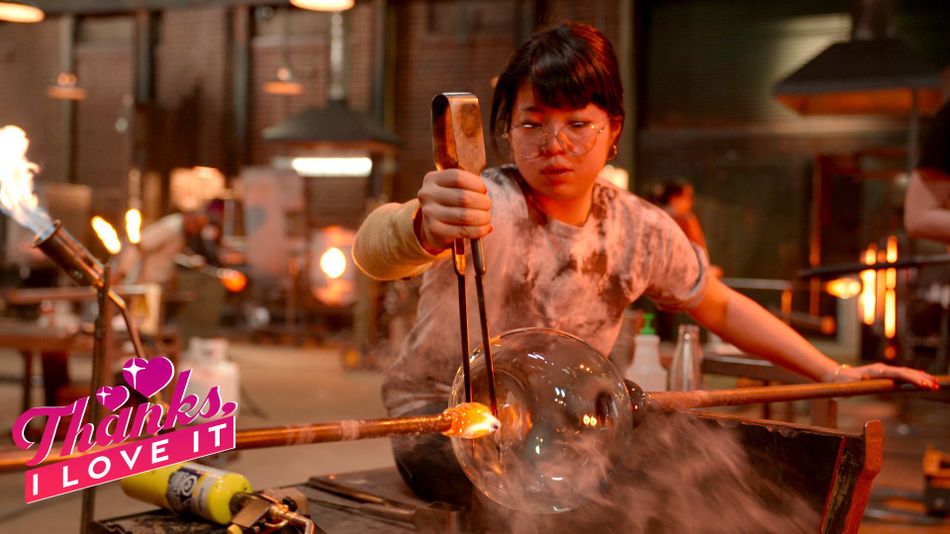
Image: netflix
Welcome to Thanks, I Love It, our series highlighting something onscreen we’re obsessed with this week.
There’s a lot to enjoy in every episode of Netflix’s Blown Away. The competition show for glassblowers has quirky competitors, fun guest judges, oodles of glasswork sex puns (drink every time someone says “glory hole”), and of course, the visual thrill of seeing simple glass turned into stunning works of art.
Blown Away‘s editing relies on slow-motion shots of artists stretching ropes of shiny, glowing glass between their tools and close ups of hands manipulating technicolor goo into fantastic shapes. That focus on the material captures the danger of working with a substance heated to 2000 degrees Fahrenheit; it also makes the glass look absolutely delicious.
Empirically, seeing a metal ladle of anything hot enough to burn a hole in a human body shouldn’t inspire hunger, but something about watching a syrup of melty goodness become candy-colored sculpture is irresistible. The desire to touch the hot glass (do not), lick the finished glass (do not), or otherwise consume it (you will die) is strong for some people and nonexistent in others — but why does that desire exist at all?
Carol Coricelli is a postdoctoral fellow at the University of Western Ontario and an Adjunct Lecturer at the University of Gastronomic Sciences in Bra, Italy. For her PhD in Cognitive Neuroscience she researched food recognition, using neural imaging techniques to examine what happens when people look at something they perceive as food. Glass is objectively not food, but her expertise lends some insight as to why the human brain might interpret molten glass as a forbidden snack. So I called her up to help explain why I wanted to eat the dangerous glass.
“When we say ‘the first taste is with the eyes’ it has a scientific basis.”
Coricelli explained that recognizing food is an intensely visual process. “One hundredth of a millisecond after you see a picture of food or a non-food, the brain responds in a different way,” Coricelli explained in a video interview this week. “Everything happens visually, so you don’t have to eat it. The interesting part is, even just viewing that food activates the taste area, so the insula, that is the primary gustatory cortex, is activated. So when we say ‘the first taste is with the eyes’ it has a scientific basis.”
People eat food to fuel their bodies, but we also eat for fun and pleasure. “Viewing food activates the hedonic response and the sensory responses,” says Coricelli, “I think that’s where all of what we’re looking at here lies. We know that we don’t eat just to restore our energy balance, that’s the homeostatic part. [There is also] the hedonic part, the reward part, everything that gives us pleasure…so looking at something very beautiful that could seem edible really activates that reward system.”
Coricelli also said that characteristics like color clue people in to what may or may not be good to eat, pointing to data that suggests people are more likely to see red food items like apples as edible than they are of blue items, which could stem from an evolutionary response to what our brains interpreted as ripe or spoiled. One contestant on Blown Away Season 2 perhaps accidentally alluded to this phenomenon, by creating glass pieces resembling a purple pizza, a periwinkle cheeseburger, and a pink doughnut with black icing. None of these look delicious at all, and Coricelli agreed: “There the colors were completely off.”
Looking back at the glassmaking process and some of the more delicious-looking finished pieces on Blown Away, the pattern that aesthetic beauty combined with a recognizable texture leads to thinking hot glass is a snack holds up. Stretching and rolling glass is a lovely process, and some of the most beautiful final entries are also the tastiest. Consider this piece by Blown Away contestant Mike Shelbo, which I sent to Coricelli with the file name “Forbidden Salad.”

Drizzle this in a little olive oil and vinegar and you’re golden. Well, you’re not. But. You know.
Image: netflix
Or this one by Cat Burns, filenamed “Forbidden Twizzlers.”

Candy! Candy! Candy!
Image: netflix
Finally there is “Forbidden Ice,” called something else by its creator Chris Taylor.

Ice chewers of the world: don’t chew this.
Image: netflix
It is kind of pleasurable to look at them, isn’t it? It makes sense that some brains would interpret these finished pieces and the smooth, melty visual of hot class as rewarding in the neurological sense. Just…don’t actually eat any of them. If humans were supposed to chomp on glass, we would have evolved to do so.
Or, as Coricelli says, “the ability to recognize if foods are actually edible is fundamental. It’s a mistake you don’t want to make.”
Blown Away Season 2 is now streaming on Netflix.
